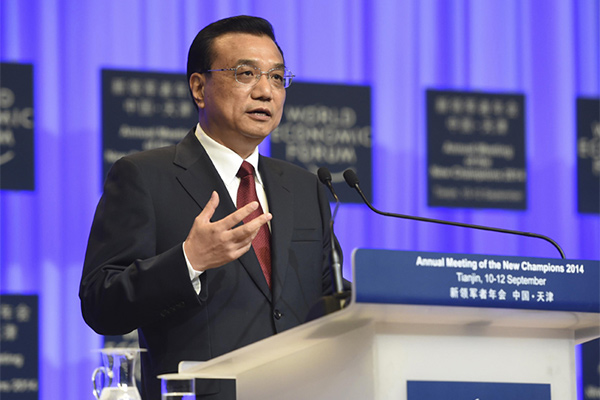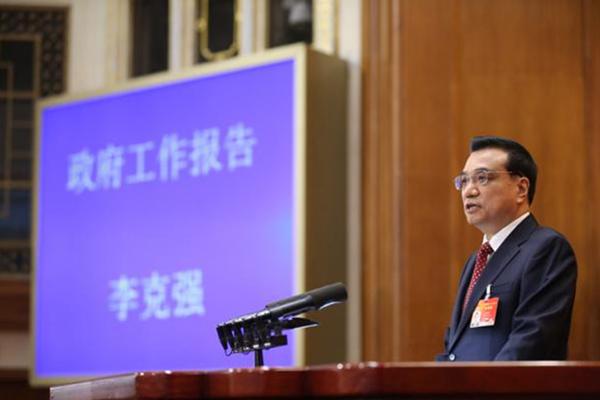
The concept of mass entrepreneurship and innovation was first proposed by Premier Li Keqiang in his keynote speech at the opening of the Annual Meeting of the New Champions 2014, also known as Summer Davos forum, in Tianjin, North China, on Sept 10, 2014.
China is witnessing a new round of reforms designed to push the world’s second-largest economy to a higher level amid downward economic pressures.
In 2016, supply-side structural reform was proceeding smoothly, with driving forces powered by mass entrepreneurship and innovation.
Since the reform and opening-up three decades ago, China has become a hot spot for more people to set up their own companies.
Mass entrepreneurship and innovation is the latest of that trend, with some new features.
Reforms such as streamlining administration and delegating power to lower-level governments are pushing forward mass entrepreneurship and innovation, which involves both elite and grassroots efforts, bolstered by technology and financial innovation.
Development of the real economy is based on both technology and financial innovation, which means the capital market should be further improved to encourage more venture capital investment to boost the country’s entrepreneurship and innovation.
New modes such as crowd-sourcing and crowd-funding should be coordinated with mass entrepreneurship to boost innovation.
Zhongguancun science park is a typical example of the combination of new innovation platforms that involve sources from many sectors and attract innovation elements such as talent, technology, capital and information.
Mass entrepreneurship and innovation can also boost employment and reduce unemployment risks amid downward economic pressures.
In the first three quarters, more than 10 million urban jobs were created, keeping the national urban unemployment rate at a low of about 5 percent.
In addition, domestic rates of patents for inventions jumped 44 percent, indicating a promising momentum of innovation in the country.

Premier Li delivers the government work report during the opening meeting of the third session of China’s 12th National People’s Congress on March 5, 2015, and proposes building the twin economic drivers of mass entrepreneurship and innovation, and optimizing public products and services.
Mass entrepreneurship and innovation in 2016
Policies released in 2016 strove to create a better environment for enterprises and individuals to forge ahead in pursuing entrepreneurship and innovation, with the goal of further stimulating new vitality into the economy.
Expand tax credits on R&D
Starting in 2016, most enterprises were able to enjoy tax exemptions for new technology and products, as part of an effort to encourage research and development (R&D) efforts.
Besides new equipment and facilities, R&D-related production costs and extra labor costs are now also on the tax deduction list for R&D enterprises.
Further eliminate tech bottlenecks
The Ministry of Science and Technology published detailed rules to implement a revision of the Law on Transformation of Scientific and Technological Achievements.
The new policy will further eliminate tech bottlenecks and stimulate researchers to transfer sci-tech achievements.
In the past, a research institute had to get approval from the Ministry of Education if they sold any technology for more than 5 million yuan ($765,000), and from the Ministry of Finance if it exceeded 8 million yuan.

On March 5, 2016, Premier Li delivers the government work report at the opening meeting of the fourth session of the 12th National People’s Congress and calls for exerting the multiplier effect of mass entrepreneurship and innovation and Internet Plus.
Turning science into productivity
To accelerate the innovation-driven development strategy, the State Council issued a document on March 1 to ensure implementation of the law promoting the transformation of scientific and technological achievements into real productive forces.
Research and development institutions and universities should get input from their staff members before making decisions on an income distribution system concerning the transformation of scientific and technological achievements, and related regulations should also be published by the organizations, said the document.
Promote startup investments
The State Council issued a circular on Sept 20 on promoting the sustainable development of startup investments, as part of an effort to advance mass entrepreneurship and innovation in China.
The circular decided to encourage multiple investors to set up venture capital enterprises or channel money into startups. The investors include investment agencies that have rich resources in entrepreneurship and innovation, such as leading enterprises, business incubators and insurance asset management institutions.
State Council to boost makerspaces
The State Council on Feb 18 issued a document on speeding up the development of makerspaces, which have flourished throughout the country, in a bid to support economic restructuring and industrial upgrade.
The policy is aimed at connecting makerspaces, the forefront of mass entrepreneurship and innovation, with other development plans such as “Internet Plus” and “Made in China 2025”, to spur the reform of leading enterprises in research, production, marketing, services and management, as well as the development of the smart “manufacturing plus services” model.

Premier Li Keqiang visited an exhibition on big data achievements in Southwest China’s Guizhou province on May 25, 2016.
Scientific and technological innovation boost
The State Council issued a national scientific and technological innovation plan in a bid to build China into an innovative country and a scientific and technological powerhouse.
The country should support Beijing and Shanghai in building scientific and technological innovation centers with international clout, set up a batch of innovative provinces, cities and regional innovation centers, promote the innovative development of national innovation demonstration zones as well as new and hi-tech development zones, according to the plan.
Innovation demonstration bases
The State Council issued a circular on May 12 to promote building mass entrepreneurship and innovation demonstration bases.
According to the circular, a total of 28 demonstration bases will be built first and are scheduled to be completed by 2018, which will help cultivate platforms to support mass entrepreneurship and innovation.
Transformation of offline retail sector
The State Council released a circular to promote the innovative transformation of the offline retail sector, in a bid to alleviate pressures from mounting operating costs and threat from thriving online retailers.
The document set up nine major tasks in the sector’s innovative transformation, from the perspective of adjusting commercial structure, to innovating its development mode, and promoting cross-sector integration.
Big data in health and medical sectors
On June 23, the State Council issued a circular regarding the application and development of big data in the health and medical sectors.
The move is set to achieve cross-sector and cross-regional data resource sharing in the country.
National and provincial population health information platforms will be built, and application platforms for national medicine bidding and purchasing will be interconnected by the end of 2017, according to the circular.
Internet Plus services to make life easier
On April 26, the State Council issued a circular regarding tests for further promotion of “Internet Plus administrative services” to benefit people through information sharing among government departments.
Over the next two years, the tests will be implemented in 80 cities. Inter-provincial digital license exchanges and online identity verification system will be fully applied in 2017, reaching the “one number, one window, and one network” target that covers more than 80 percent of basic public services, according to the State Council.
